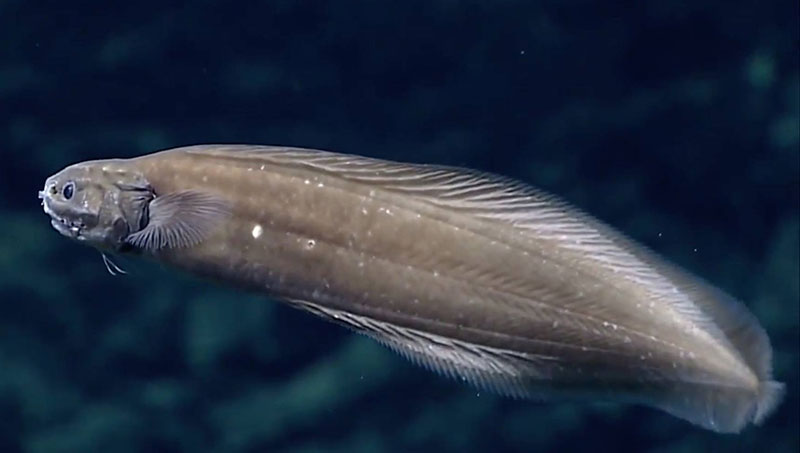How far does light travel in the ocean?
Light in the ocean decreases with depth, with minimal light penetrating between 200-1,000 meters (656-3,280 feet) and depths below 1,000 meters receiving no light from the surface.

This unpatterned, brown cusk eel (probably an undescribed species) has color typical of many fishes living near the bottom between 0.5 and 3.6 miles (1,000 and 6,000 meters) down in the ocean, where no light penetrates. The eye is large and can detect dim light produced by other animals, but it may not be able to see full images. Image courtesy of NOAA Office of Ocean Exploration and Research, 2016 Deepwater Exploration of the Marianas. Download image (jpg, 38 KB).
The importance of light in the ocean is reflected by the description of the ocean’s vertical zones of the water column in terms of how much light these zones receive. The ocean is generally divided into three zones which are named based on the amount of sunlight they receive: the euphotic, dysphotic, and aphotic zones.
Euphotic Zone (Sunlight Zone or Epipelagic Zone)
The upper 200 meters (656 feet) of the ocean is called the euphotic zone. Since sunlight penetrates this zone sufficiently to support the growth of phytoplankton and/or macro algae (i.e., plants that need sunlight to make food and survive), providing the bulk of ocean primary production (food), it is also known as the sunlight zone (or epipelagic zone). Organisms in the zones below are dependent on what food drifts down from above, ranging from tiny clumps of bacteria and dead algae to occasional bonanzas like a dead whale.
Dysphotic Zone (Twilight Zone or Mesopelagic Zone)
The area between 200 and 1,000 meters (656 and 3,280 feet) is the dysphotic zone. Also known as the twilight zone (or mesopelagic zone), light intensity in this zone is severely reduced with increasing depth, so light penetration is minimal. About 20 percent of primary production from the surface falls down to the mesopelagic zone. Consequently, the density or biomass of mesopelagic zone occupants is lower than at the surface, and mesopelagic organisms have an interesting variety of mechanisms that help them find food as well as avoid being meals for other species.
Aphotic Zone (Bathypelagic, Abyssopelagic, and Hadopelagic Zones)
Sunlight does not penetrate the eternal darkness below 1,000 meters (3,280 feet), an area known as the aphotic zone, which includes the midnight zone (or bathypelagic zone) between 1,000 and 4,000 meters (3,280 and 13,123 feet), the abyss (or abyssopelagic zone) between 4,000 and 6,000 meters (13,123 and 19,685 feet), and the hadal zone (or hadopelagic zone) 6,000 meters (19,685 feet) and deeper. The only light available at these depths is generated by organisms. About five percent of the primary production from the surface makes it to the bottom of the ocean. Less food means lower biomass. Occasionally, large items like dead sharks or whales reach the seafloor, but generally food is scarce.